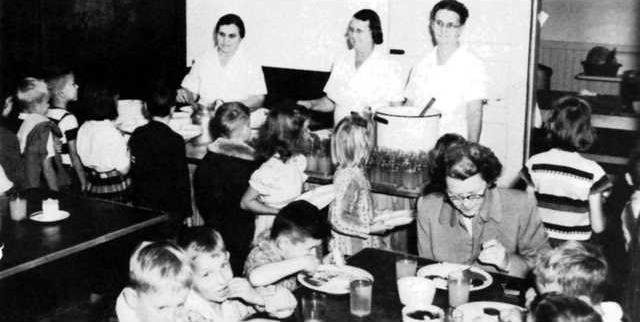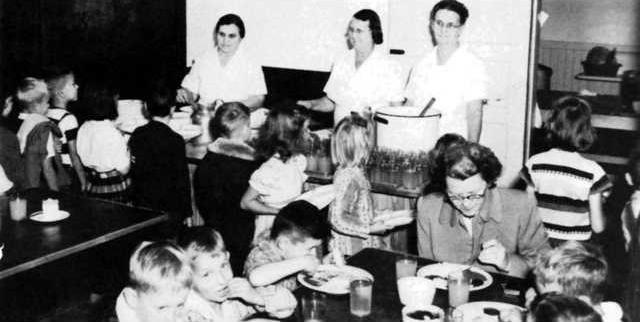“Perhaps the most underpaid and underappreciated people employed in the school system have been our lunchroom workers,” said 97-year-old retired teacher, Mrs. Edna Morgan.
When she began teaching at Clyo in 1937, the lunch room program had already begun. The Depression and President Roosevelt’s “New Deal” was the beginning of what we know now as the lunchroom program. Government commodities in the early years that were supplied included flour, ground yellow corn for meal and grits, dried beans, butter, canned fruit, peanut butter, and honey. Teachers recall eating ground beef prepared differently for four days of the week if that is what the commodities provided.
Clyo used honey mixed with peanut butter for sandwiches while Egypt could not figure out what to do with all the honey, until they shared some with Clyo and found out how to utilize it.
At first there was a kitchen but no dining room, so the workers prepared the meals and brought food to the classroom for the children to eat. Mrs. Edna remembers a lot of soup and sandwiches at first. Later, dining rooms were added.
Some could not afford the meals and in the early days, according to Mrs. Morgan, their parents contributed home canned foods in trade for meals. That soon came to an end as the lunchroom program was not allowed to use these home-prepared items since the school could not guarantee the sanitary conditions of the preparation of the foods. Some children brought lunch because they could not afford meals, and some brought what they preferred to eat from home. This still rings true today.
The early accompanying pictures show the very crude conditions where the ladies toiled to prepare food in the days before air conditioning. Now there are shiny pieces of equipment and food that comes partially prepared that improve the quality of meals and offer ease of preparation. No doubt the quantities prepared are large and the pots and pans are heavy and lunch room work is still very demanding. Dishes are no longer washed by hand. Packaged milk makes service easy and sanitary.
Many recall Miss Lula Ford of Effingham Academy and later the consolidated Effingham County High School. Her freshly baked biscuits, yeast buns and rolls, sweet rolls and cake squares were delicious!
Although these heroes of the kitchens were poorly appreciated, we all benefited from their dedication and hard work providing us meals at an affordable price for most people. The subsidy program for low-income families allowed the meals to be available to all students as times changed. Breakfast as well as lunch is available in the modern dining rooms of our schools today.
What was your favorite lunch room treat? Perhaps it was sloppy joes on home baked buns, thick squares of deep-dish pizza homemade from the oven, tuna salad with sweet rolls, beef stew, sausage and red rice or a hamburger? Each of us had our favorites and there were those days when we disliked the meal.
Now there is a choice, and the choices are made available ahead to plan to dine in or bring a lunch from home. At the time of our own education, many of us did not appreciate these meals, but now as adults, we realize that the meals were pretty good and these ladies toiled hard to feed us.
Enjoy your lunch when you dine with your child or grandchild by appointment in our schools. It will bring back memories and show you how times have changed.
The Bulldog annuals for 1954 and 1955 were provided by John Tebeau. The Pathfinder 1956 annual from Marlow came from Irma K. Davis. Thanks for the help. This was compiled by Susan Exley of Historic Effingham Society If you have photos, comments or information to share, contact Susan Exley at 754-6681 or email her at: hesexleyherald@aol.com.








